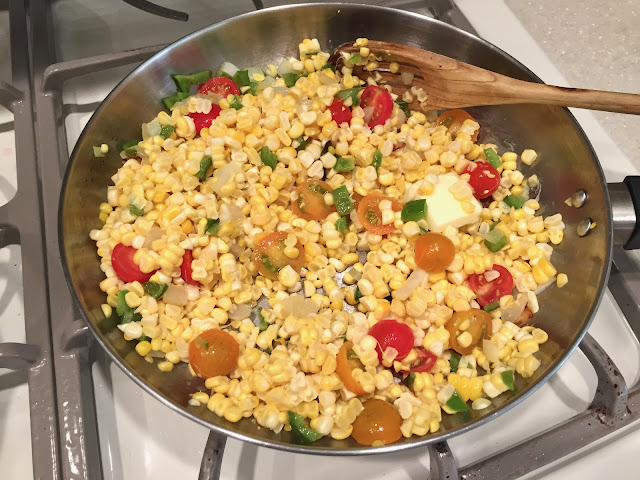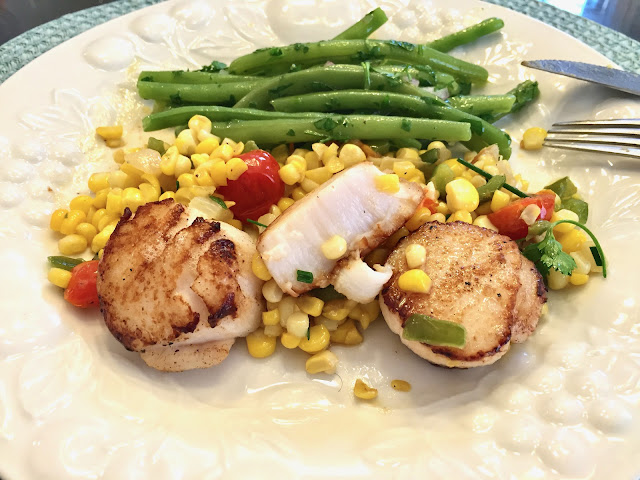 Looking for a delicious main course that’ll impress your guests, but is easy enough for an every day meal? Look no further than this pork tenderloin roast, cooked with figs and olives, a recipe inspired by my friend, Marie, whose blog, Proud Italian Cook, always leaves me hungry.
Looking for a delicious main course that’ll impress your guests, but is easy enough for an every day meal? Look no further than this pork tenderloin roast, cooked with figs and olives, a recipe inspired by my friend, Marie, whose blog, Proud Italian Cook, always leaves me hungry.It’s near the end of fig season here in the Northeastern U.S., and if you don’t have your own fig tree, I hope you have FWF (friends with figs). My own fig tree, a new transplant that produced only one edible fig so far this year, was not up to the task, but fortunately I have a few FWFs, including my friend Dorothy, who invited me to help myself.
The recipe calls for some fig preserves, and fortunately, I still had some I made earlier in the year. But you can easily purchase fig preserves from the store.
I stewed them for a few minutes in port wine to soften them a bit. Careful not to cook them too long, or they’ll lose their shape since they cook further in the oven. Port wine and figs are a match made in heaven, but if you haven’t got port, you can use red wine, or even just water if you don’t imbibe at all. Add a cinnamon stick to the liquid for even more flavor. Make a paste of fig preserves, garlic and some herbs and spread it over the roast. Surround it with the drained figs, scatter around some olives and sections of red onion. The first time I made this, I browned the meat, but much of the paste burned, causing me to scrape it all off. So I eliminated that browning procedure entirely the second time and it was delicious even without taking that step.
Make a paste of fig preserves, garlic and some herbs and spread it over the roast. Surround it with the drained figs, scatter around some olives and sections of red onion. The first time I made this, I browned the meat, but much of the paste burned, causing me to scrape it all off. So I eliminated that browning procedure entirely the second time and it was delicious even without taking that step.
- 1 pork tenderloin, 1 to 1 1/2 pounds
- 1 dozen ripe figs, cut in half lengthwise
- 1 large red onion, sectioned in pieces
- about 1/2 cup green and black olives
- MARINADE FOR THE PORK
- 2 tablespoons fig preserves
- 2 tablespoons grainy mustard
- 1 large garlic clove
- 1 tablespoon each minced rosemary and thyme
- salt, pepper
- POACHING LIQUID FOR FIGS
- 1/2 cup port wine and 1/2 cup water
- 1/4 cup honey
- 1/4 cup fig preserves
- 1 cinnamon stick
- Place the port wine, water, honey, fig preserves and cinnamon stick in a saucepan and bring to a boil.
- Reduce the heat, add the figs and poach gently for about five minutes to soften and imbue the figs with more flavor.
- Mix the marinade ingredients together and smear over the pork in the roasting pan.
- Let the pork sit at room temperature with the marinade for about 1/2 hour.
- Fan out the onion sections around the pork, and also scatter the olives and drained figs in the pan.
- Spoon a little of the poaching liquid on the roast and place in a 425 degree oven for about 20-30 minutes or until a thermometer reads 145 degrees.
- Remove from the oven and cover with aluminum foil and let it rest 5-10 minutes.
- If the poaching liquid is not thick enough to your liking, reduce over high heat for a bit.
- Slice the roast and ladle some of the poaching liquid on top before serving.












.jpeg)










